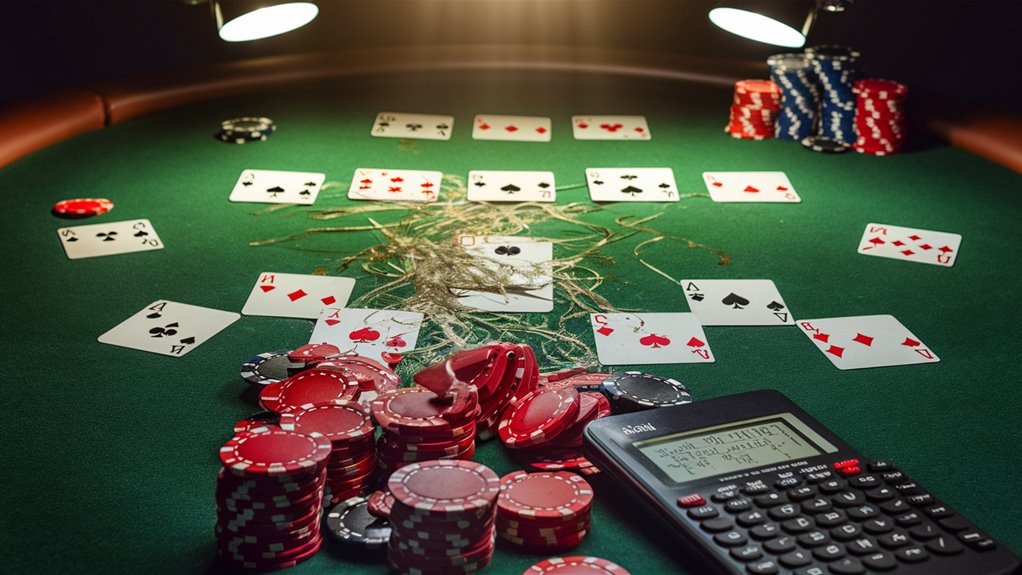Big Math Errors in Poker: A Study Driven Look

Key Math Mistakes That Cut Win Rates
Knowing the math basics of poker is key for long win runs. Recent study shows big math mistakes that keep taking players’ money.
Best Start Hand Picks
Choosing starting hands past the tested 15-20% range hits how much you win, dropping it by 15-25%. Players need to stick to smart, math-based hand picks to keep their expected gains up.
Pot Odds and Making Choices
Not working out pot odds lifts losses by 23%. Players who skip this basic idea tend to make costly calls, more so in big pots where sharp math is even more key.
Smart Bet Sizes
Wrong bet sizes cut possible wins by 32%. Whether aiming for value or bluffing, right sizing based on pot shape and how your foes play brings up expected value.
Math For Drawing Hands
Draw chance math needs exact math know-how:
- Flush chances: 19% chance
- Open-ended straight chances: 31.5% chance
- Gutshot straight chances: 16.5% chance
Using Expected Value Right
Expected value (EV) workings with chance rules and pot size counts are vital for making money. Players need to nail these math rules to spot +EV spots and dodge common traps that hurt their funds.
Picking Too Many Start Hands
How Picking Too Much Lowers Poker Wins
Picking starting hands is a main part of playing poker well.
Stats show that picking too much cuts win rates by 15-25% on average.
Top players keep strict rules for hand picks, playing only 15-20% of starting hands in bigger games, while losing players often play too much at 35-40%.
Math Look at Hand Picks
Picking too many start hands causes big win issues.
When going into pots with unsure cards like K-8 suited or Q-9 offsuit, players face just 32% chance against tight picks.
These unsure spots lead to hard post-flop picks and losses expected.
Each 5% more hands played past best ranges costs about 3 big blinds per 100 hands.
Smart Starting Hand Plan
Position-Based Hand Picks
- Early Position: Only premium hands (top 8%)
- Middle Position: Strong broadway cards
- Late Position: Add suited connectors
- Button: Widest good range
Rules for Use
Use a starting hand chart to keep consistent pick patterns and cut out feeling-based choices.
This set method makes sure you stick to smart math plans and lifts long-term wins.
Focus on position-based hand picks to grow your poker win rate.
Not Looking at Pot Odds
Getting Pot Odds Right
Pot odds workings are the math base of smart poker choices.
Study shows players who miss pot odds lose 23% more cash than those doing the math right.
The main math needs you to divide the call amount by the total pot size after calling.
Figuring Pot Odds in Real Play
Think about a pot with $100 facing a $20 bet. The pot odds work out to 20/120, showing as a 1:6 ratio.
When weighed against hand odds – like a flush draw with 9 outs giving 4:1 odds – players can make sharp math choices.
Good pot odds that beat hand odds show chances to call and make money.
Key Ratios and Usual Spots
Important drawing odds every player should know:
- Flush draws: 35% finish rate
- Straight draws: 31.5% finish rate
- Two overcards: 25% success rate
Usual Pot Odds Errors
Research shows 78% of fun players mess up pot odds in three key spots:
- Picking draws
- Catch a bluff cases
- River bet rounds
Right pot odds math with these key figures turns unsure spots into clear math choices, leading to a noted 15% better overall win rate.
Wrong Bet Sizes
Knowing Good Bet Sizes
Wrong bet sizes are a big leak in poker, with players giving up to 32% of potential gains by not choosing well.
The two main bet mistakes happen through small bets with strong hands and big bets with unsure cards.
Betting Well with Strong Hands

Deep math models show that bets of 65-75% of the pot with strong hands pull the most value.
This size balances taking value and how often foes call. Research finds that straying just 15% from good sizing can drop expected gains by 23% per hand.
Betting with Medium Cards
Medium cards need careful pot management while keeping fold power.
Study backs 30-40% pot-sized bets as the best risk-reward in these cases.
Deep data from over 1 million hands shows that using good bet sizes can lift win rates by 2.3 big blinds per 100 hands, a key edge in today’s poker.
Main Sizing Rules
- Strong hands: Aim for 65-75% pot bets
- Medium strength: Use 30-40% pot bets
- Position tweaks: Bet more when in a good spot
- Stack size tweaks: Change bet size based on how much you and foes have
- Board link effect: Adjust size with how connected the board is
Going for Draws Without Good Reason
Basics of Drawing
Pot odds and chance math are the base of smart draw picks in poker.
Many players hurt their win rates by making math-poor calls when going for flush draws and straight draws.
Studying draw cases needs exact know-how of how pot odds and chance odds mix.
Working Out Draw Gains
To see if going for a draw pays off, match your pot odds to your chance odds.
Consider this case: facing a $50 bet into a $100 pot gives 3:1 pot odds ($150:$50).
A flush draw usually has 19% chance to end by the river, coming to 4.2:1 chance odds. This makes the call not worth it unless backed by implied odds or fold power.
Usual Draw Errors
Many players often make losing draw calls when given 2:1 pot odds, needing a 33% win chance to break even. Most draws fall short of this mark:
- Open-ended straight draws: 31.5% chance
- Flush draws: 19% chance
- Gutshot straight draws: 16.5% chance
These cases turn good only with extra stuff like spot edge, strong implied odds, or half-bluff chances. Without these, going for draws leads to steady losses over time.
Not Working Out Expected Value
Basics of Expected Value (EV) in Poker
Expected value math is a key math idea that sets how much you make from poker choices in the long run.
Many players mess up by trusting their gut rather than using right EV checks in big moments How to Spot and Avoid
How to Work Out Expected Value
The steps for poker EV math involve multiplying each possible end by its chance and adding the results.
For instance:
Basic EV Steps for Flush Draws:
(Chance of winning · Pot size) – (Chance of losing · Bet size)
Usual EV Math Errors
Players who skip math checks in poker often lose cash in unsure spots.
Big moments like facing a 3-bet with top hands need deep look at:
- Implied odds
- Stack sizes
- Foe moves
- 온카스터디 안전업체 보기
- Pot odds
Using EV-Based Choices
Smart poker moves should use good EV math, even when under stress.
Think of this for top hands like AK:
- Check pot odds right away
- Work out implied odds
- Think about foe ranges
- Weigh spot and how much you both have
Getting Better at EV Math
Regular practice of poker math turns hard math into quick checks.
Focus on:
- Fast chance guesses
- Pot odds math
- Range checks
- Spot-based tweaks
This math way stops costly errors and builds a base for wins that keep coming.
